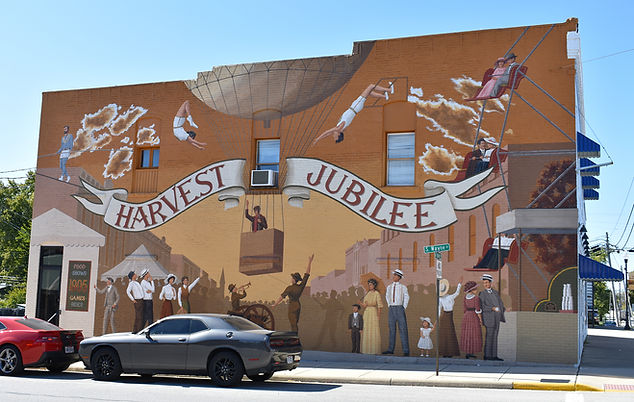Touring the Land of Cross-Tipped Churches
& Historic Fort Recovery
Story & Photos by Matt Bayman







There is a sense of freedom, peace and wonder that comes with touring the Land of the Cross-Tipped Churches in western Ohio. Often located in quaint small towns and villages with one stop light or less, and sometimes in even more remote places, the 60 religious structures that make up this region are steeped in history, beauty and grandeur and located along some of the most picturesque back roads in Ohio.
Tourists can visit 34 of these structures by taking a driving tour of the region. It passes historic Catholic churches, schools, rectories and convents that all date from the late 19th and early 20th centuries and that are listed on the National Register of Historic Places. As the name indicates, many of the churches contain tall and elaborate cross-tipped steeples that tower above the mostly flat farmland in the area. They are centered near the Village of Maria Stein, south of Grand Lake St. Marys, and represent the German Catholic immigrants who settled in southern Auglaize and Mercer counties and parts of northern Darke and Shelby counties in the 19th century. Many German immigrants helped build the Miami and Erie Canal that passed through western Ohio and decided to settle in the area. Many of them were of the Catholic faith.
The churches and religious structures were built by the Society of the Most Precious Blood under the leadership of missionary priest Francis de Sales Brunner. Not all of the buildings remain today.
The cross-tipped “spires to heaven” that the Society built, which can be seen from miles away in all directions, are often complimented by dazzling gardens, statues, outdoor Stations of the Cross, elaborate and colorful stained-glass windows and stunning architecture and landscaping.
Travelers can visit each building, tour the grounds, see the insides of many of the churches and enjoy the peaceful country scenery and fresh air. Oftentimes, visitors have the entire place to themselves. It offers a chance to reflect in a very peaceful and serene environment. It’s also free to do.

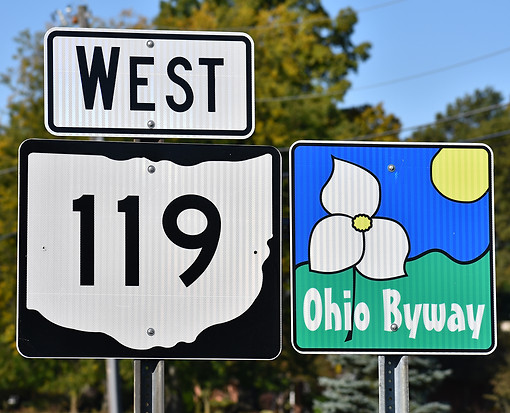
A major highlight of the tour is the Maria Stein Shrine of the Holy Relics located at the former Maria Stein Convent. It houses the second largest holy relic collection in the United States and also features a museum that covers the relics, the history of the convent (including what life was like for the nuns), regional canal history and more. The museum is open daily and admission is free.
Most of the 1,100 holy relics are body parts (bones and teeth) of saints or objects that belonged to them. The pride of the collection is a splinter of the True Cross and a splinter of bone from St. Pergrine, the patron saint of patients with cancer. The relics are housed in large intricate German carvings that date from the 18th and 19th centuries and are located in the Sacred Heart Relic Chapel at the convent. At one time, nuns kept a continuous vigil in the chapel. Today, visitors will still find dozens of candles glowing in the solemn and hallowed space.
Behind the convent is a courtyard that contains the Stations of the Cross and other statues and shrines. Next to it is a garden of statues that honors Catholic saints and Christ. There’s also a short hiking trail that leads to an outdoor chapel. An hour or more can be spent touring the building, museum and grounds.
One of the most jaw-dropping structures on the tour is the St. Charles Seminary and Chapel, built in 1906. The massive Romanesque-style building sits on 500 acres near the Village of Carthagena and is surrounded by cornfields. It served as a seminary school until 1969 before becoming the St. Charles Center, where it served as a home for active and retired priests. Today it is an independent living facility for those 55 and older. While visitors are not allowed to tour the inside of the building, the exterior gardens and Stations of the Cross are open to the public and are worth a visit. A set of binoculars is helpful when viewing this and other buildings. The steeples and churches really are massive structures and some of the finest work and details can be found at the highest points on the buildings and steeples.
The original Mother Church for the Society of the Most Precious Blood is located in Minster. It is called St. Augustine Church and it was built in 1849. It stands out for numerous reasons. It is a Neoclassical, Gothic Revival-style church that features two matching steeples and eight black-faced tower clocks. A half barrel ceiling inside of the church is adorned with seven paintings by Chicago painter Joseph Vittur.
Minster is one of the larger towns visited on this tour and it contains several memorable restaurants and shops, as does St. Henry. St. Henry Catholic Church is also the tallest church on the tour, standing at 202-feet-high.
(STORY CONTINUES BELOW CHURCH IMAGES)


ABOVE LEFT:
St. Peter & Paul Church in Newport
Although not part of the Land of Cross-Tipped Churches, this church on Ohio Route 66 in Newport is still very stunning.
ABOVE RIGHT:
St. Rose Church Complex in St. Rose
Built in the shape of a Latin cross, this church is known for its octagonal steeple, topped with a louvered belfry and two miniature square towers on each side of the main steeple.




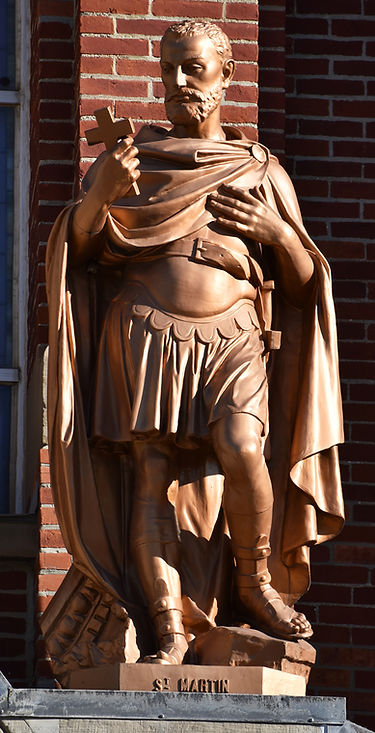


ABOVE:
St. Michael Church Complex in Fort Loramie
One of the most detailed churches, and grandest, is the St. Michael Church Complex in Fort Loramie, which is another town filled with interesting history and food! According to ODOT, more than one million bricks were made for this structure and its 200-foot-tall tower. The church can be seen from nearby Lake Loramie State Park, which itself is a beautiful place.
BELOW:
National Maria Stein Shrine of the Holy Relics and Former Convent & St. John the Baptist Church and
Rectory
The shrine was founded in 1875 and features four stained-glass windows imported from Munich, Germany. The Heritage Museum is located in the former convent and is open daily. The nearby St. John the Baptist Church and Rectory were built in 1888.

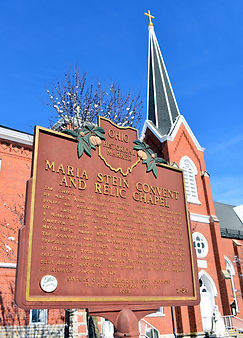





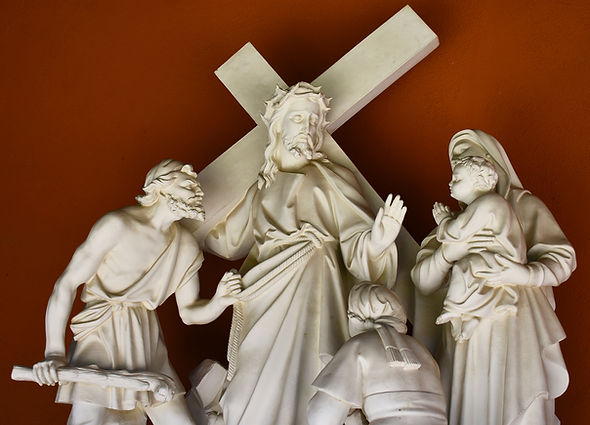

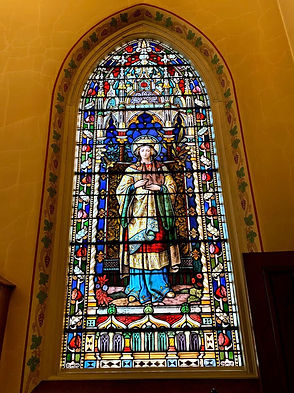




BELOW:
St. Augustine Church in Minster
These tall towers rise far above the flat farmland that surrounds Minster. To truly enjoy this church, view it from all angles and from the inside.


BELOW:
St. Joseph Church and Rectory in Egypt
Built in 1887, this church’s floor plan is the shape of a Latin cross. The interior of the church is ornamented with frescoes on the walls and a heavily decorated ceiling.
Egypt is a place where several cross-tipped church steeples can be seen from one location. The town’s altitude makes it ideal for this.
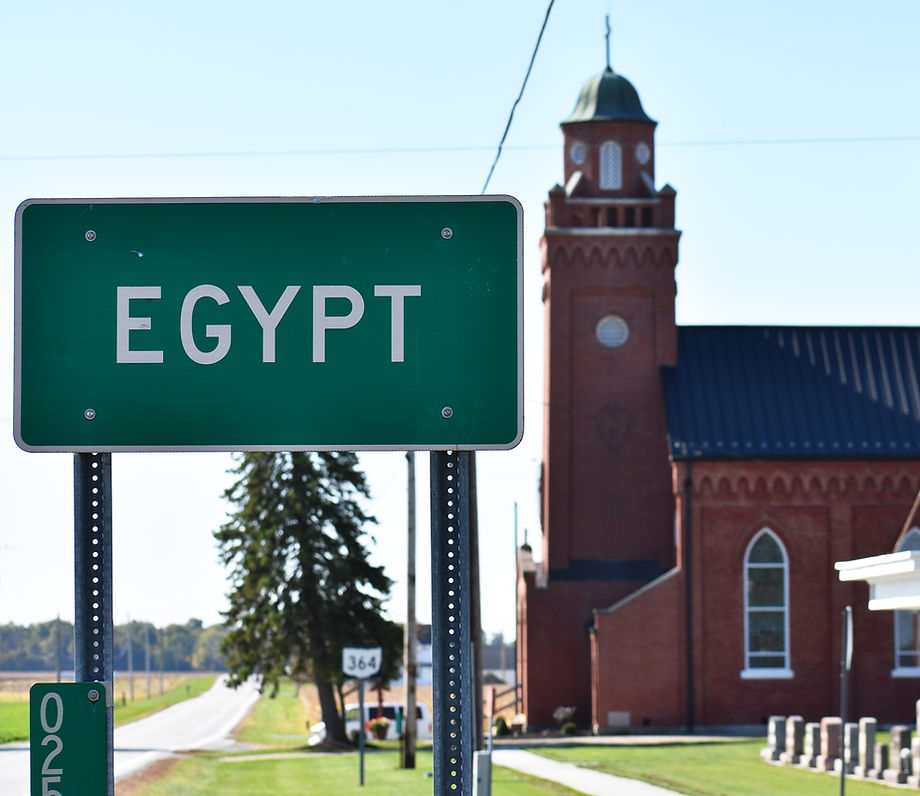
BELOW LEFT:
Nativity of the Blessed Virgin Mary Church and Rectory in Casella
Built in 1862, this church was nearly destroyed by a fire in 1888, although the original walls remained. According to ODOT, which keeps a map of the churches online, damage from the fire was visible until 1915 when a group of traveling German craftsmen covered it with cut stone, which is what is seen today.
BELOW RIGHT & BOTTOM LEFT:
St. Francis Church and Rectory in Cranberry Prairie
Constructed in 1906 and featuring a 112 foot tower, the artistic windows on this church were donated by different families of the parish and include a large window showing St. Francis of Assisi sitting among a large gathering of woodland creatures.
BOTTOM RIGHT:
The Cranberry Prairie
Located at St. Francis Church is this historical marker. It commemorates the location of a natural cranberry field that once grew in this former swampy area. An elk skeleton that had been killed by human hunters was dug up at the site in 1981 and dated to 7,400 B.C.




BELOW:
St. Charles Seminary and Chapel in Carthagena
This apostolic community of priests and brothers was founded in 1815. The building is now closed to the public, but the grounds are open. It includes gardens, Stations of the Cross and numerous statues and outdoor chapels. A walk around the massive building is worthwhile.




BELOW LEFT:
St. Aloysius Church in Carthagena
Located next to the St. Charles Center, this rural church was built in 1877 in the Gothic Revival style. The church stands out for its tower, which is equipped with a white-painted wooden belfry and a tall spire.
BELOW RIGHT and BOTTOM:
St. Henry Church
The tallest and most expensive (at the time) church in Ohio, the St. Henry Church was built in 1897. While in St. Henry, dine at the famous Fish Mo’s Sports Bar & Grill. Just look for the giant scoreboard on the side of the building.



BELOW LEFT:
St. Marys Church and Rectory in Philothea
Built in the Greek Revival style, the interior of this church features stained-glass windows, a marble baptistery and pipe organ, as well as a painting of Our Lady Queen of the Rosary on the ceiling.
BELOW RIGHT:
St. Peter Church and Rectory in Fort Recovery
Known as an excellent example of American High Victorian Gothic Revival architecture, this church contains rare stained-glass windows.


BELOW LEFT:
St. Joseph Church and Rectory in St. Joe
Constructed in 1861, a highlight of this church is an interior feature that displays statues of the four evangelists—Mark, John, Luke and Matthew. A set of stained-glass windows depicts the life of St. Joseph.
BELOW RIGHT:
St. Paul Church and Rectory in Sharpsburg
The current church was built in 1888 after the previous building on the property was destroyed in a fire.
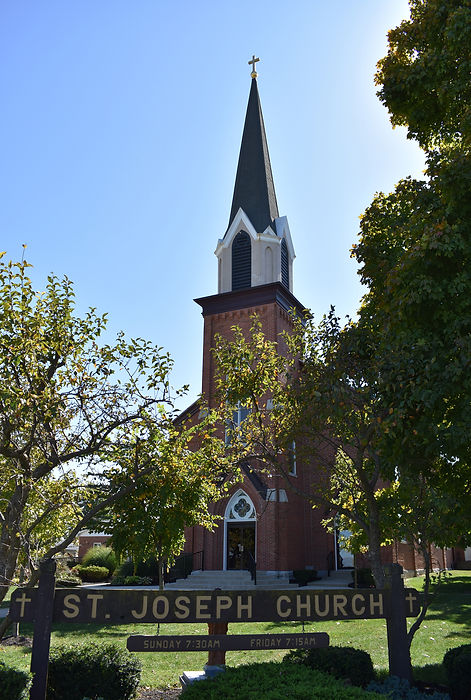

BELOW
St. Wendelin Church Complex in Wendelin
Built in 1870, this church has a rectangular shape and tower. According to ODOT, to save on costs, parishioners made, burned and limed the bricks by hand.

BELOW
Holy Family Church in Frenchtown
One of the more secluded, yet visually striking churches on this tour is the Holy Family Church. Built in 1866, it has a gabled roof topped with a bell tower. It is not as tall as other churches in the region, but it is considered to be a fine example of a well-preserved Gothic Revival building.

BELOW:
St. Bernard Church and Rectory in Burkettsville
The construction of this church began in 1915, but according to ODOT, it was halted due to the beginning of World War I. Construction resumed in 1922 and was completed in 1924.


BELOW LEFT:
St. Remy Church in Russia
According to ODOT, St. Remy was rated as one of the most beautiful churches in the Archdiocese of Cincinnati and one of its purest examples of Romanesque Revival architecture.
BELOW RIGHT:
St. Louis Church and Rectory in North Star
This single-story church bears evidence of the French Renaissance style of architecture and is the only one of its kind in the Land of Cross-Tipped Churches.
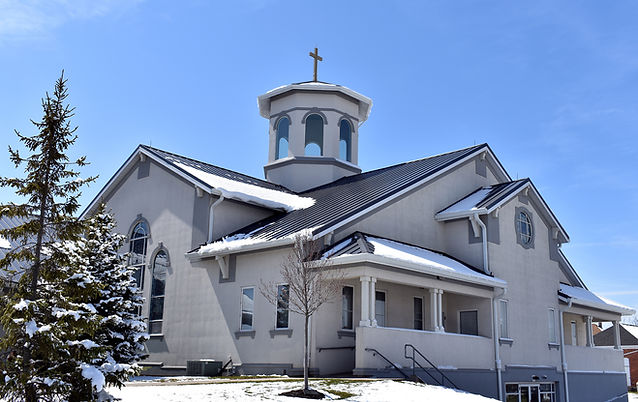

FORT RECOVERY
On the far western end of the Land of Cross-Tipped Churches is the Village of Fort Recovery (pictured below). Although it doesn’t contain any churches featured on the tour, it has a lot of interesting things to see and do, and a rich history.
One of the best ways to experience Fort Recovery is to take the Battles of the Wabash and Fort Recovery Walking Tour. It’s a 1.5-mile loop tour that includes 15 wayside exhibits in the former battlefield area (now a park) and in town. It starts at the Fort Recovery State Museum, which contains a replica fort and exhibits, and also visits the Remembrance of Today monument in the center of town. This 101-foot obelisk sits atop the burial vault of those killed in the Battle of Wabash and Battle of Fort Recovery.
The Battle of Wabash occurred in 1791 and was fought between the Western Confederacy of Native Americans and the U.S. Army. The confederacy won and the battle is considered “the most decisive defeat in the history of the American military” and its largest defeat ever by Native Americans. The Battle of Fort Recovery, or Siege of Fort Recovery as some call it, took place in 1794. This time, although the U.S. Army took heavy casualties, they were able to fight off the Native American advance.
Along with the walking tour, outdoor exhibits, museum and monument, Fort Recovery pays homage to its history with a series of detailed murals that depict the two battles. Another mural honors the Harvest Jubilee—a popular festival that takes place each June in the community.
Along with the Land of Cross-Tipped Churches and Fort Recovery, this tour visits a number of other hidden treasures. This includes the Niekamp Farm Market near St. Henry, Lake Loramie State Park and some of the best small towns in the Midwest.
One of the great things about this tour is that it can be done any time of year. The entire region is just as picturesque in the winter and spring as it is in the summer and fall. This is a good thing, because it’s really a place you want to revisit many times.
How to Take the Tour
Starting in Piqua (which itself contains beautiful churches built during the same time period), the following tour uses Ohio Route 66 and Ohio Route 119 (both Ohio State Scenic Byways) to reach Fort Recovery. It then returns home on U.S. 127 near Versailles and visits the final stops on the Land of Cross-Tipped Churches tour.
The 34 structures are not all located on these roads, but are close-by. Complete maps of the region can be obtained from the Auglaize-Mercer Counties Convention and Visitors Bureau or online HERE. The visitor’s bureau also offers guided tours of the region by calling (419) 394-1294.





